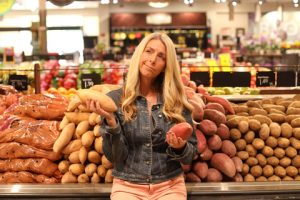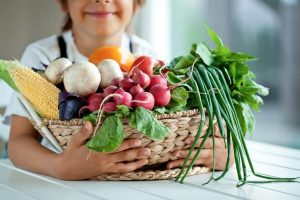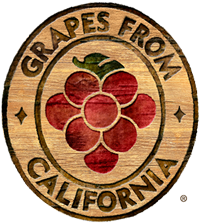Yam or Sweetpotato? Sweetpotato or Sweet Potato? Answers Here
 It happens every Thanksgiving. You head to the grocery store to shop for the big day. Of course, you’ll need to buy yams for the family’s favorite casserole. But when you get to the produce department, the display sign says “sweetpotato.” Or perhaps some are labeled as “yams” and others are “sweetpotatoes.” Which should you buy? And what’s the difference between a sweetpotato and a yam anyway?
It happens every Thanksgiving. You head to the grocery store to shop for the big day. Of course, you’ll need to buy yams for the family’s favorite casserole. But when you get to the produce department, the display sign says “sweetpotato.” Or perhaps some are labeled as “yams” and others are “sweetpotatoes.” Which should you buy? And what’s the difference between a sweetpotato and a yam anyway?
This Thanksgiving, California sweetpotato farmers are on a mission to end this confusion once and for all. Their message is really very simple: Yam = Sweetpotato
“Sweetpotatoes come in all kinds of colors – red, orange, white, and, even purple. You may see them labeled as yams in the grocery store, but they’re actually sweetpotatoes,” explains Sarah Alvernaz, who farms sweetpotatoes in the heart of California’s sweetpotato growing region.
Alvernaz and other California growers who make up the California Sweetpotato Council are working to educate consumers and put an end to all the confusion about sweetpotatoes versus yams, particularly for younger consumers who may not be interested in eating yams but have heard that sweetpotatoes are a superfood.
“True yams are very different from sweetpotatoes and are a starchy, tuberous vegetable mostly grown in Africa,” explains Alvernaz. “You are unlikely to find true yams at a U.S. supermarket, despite what you might see on display signs.”
Unlike yams, sweetpotatoes are native to the Americas. The United States produces approximately 1.7 million tons of sweetpotatoes each year. California is the second largest producing state for sweetpotatoes because the warm dry climate and sandy soils of California’s Central Valley provide the optimum growing environment for quality roots. Some 90 percent of California’s sweetpotatoes are grown within a 20-mile radius of the small town of Livingston and the remaining 10 percent are grown near Bakersfield.
Alvernaz also explains that it’s common to see some sweetpotatoes at your grocery store labeled by varietal names such as Covington, Garnet or Jewell. But growers actually produce dozens of different varieties.
“We’re encouraging retailers to label sweetpotatoes according to color,” notes Alvernaz. “Most varieties we grow can be accurately categorized as either red, orange, white or purple sweetpotatoes. All four types have similar cooking times and can be used pretty much interchangeably in recipes.”
“We just want people to know that sweetpotato is a modern, more accurate term than yam,” says Alvernaz. “Even if they’re labeled as yams in the store, they are sweetpotatoes! Whether they’re red, orange, white or purple – all can be used in any recipe that calls for yams. Sweetpotatoes are a versatile, delicious superfood available every day of the year.”
To help support this message, the California Sweetpotato Council is working with retailers to correctly label sweetpotatoes in their stores. Shoppers can find simplified, updated information about sweetpotatoes here.
“Rest assured the Thanksgiving yam dish that’s been in your family for generations has always been made with sweetpotatoes,” says Alvernaz. “Probably with red or orange varieties but go ahead and buy whatever color you find in your store. And don’t forget that sweetpotatoes can be used in a variety of recipes not just for the holidays.”
Alvernaz adds that sweetpotatoes are, in fact, a superfood with each containing over 80 nutrients. They’re high in vitamin B6, vitamin A, carotene, and potassium, they’re rich in antioxidant vitamins C and E and are a great source of manganese and dietary fiber.
More information about sweetpotato nutrition, cooking facts and delicious recipes can be found at the California Sweetpotato Council website here.
For the record, the council says it’s sweetpotato, not sweet potato: On this one we admit there’s not a lot of agreement. But we believe that “sweetpotato” is correct because our product is not, in fact, a sweet potato. It’s not a potato at all, but botanically an entirely different vegetable, gifted with a totally different set of better-for-you nutrients, amazing taste, and incredible versatility. So sweetpotatoes—one word—is not only grammatically correct, but it helps make the distinction.
For more news of interest to the specialty food industry, subscribe to Gourmet News.
USDA Invests $52M to Improve Access to Fruits, Vegetables
 The U.S. Department of Agriculture is investing more than $52 million to improve dietary health and access to fresh fruits and vegetables for eligible families.
The U.S. Department of Agriculture is investing more than $52 million to improve dietary health and access to fresh fruits and vegetables for eligible families.
The funds support efforts across three National Institute of Food and Agriculture competitive grant programs that make up the Gus Schumacher Nutrition Incentive Program.
The program is named in honor of the former USDA Under Secretary of Agriculture for Farm and Foreign Agricultural Services (1997 to 2001).
“USDA is delivering on its promise to bolster food and nutrition security for underserved communities,” said USDA Chief Scientist and Under Secretary for Research, Education and Economics Dr. Chavonda Jacobs-Young. “Investments like this enable people to afford and eat healthy fresh fruits and vegetables so they don’t have to make a choice between healthy eating and cheaper less healthier options.”
GusNIP’s three grant programs include Nutrition Incentive, Produce Prescription and the Nutrition Incentive Program Training, Technical Assistance, Evaluation and Information Center. By bringing together stakeholders from various parts of the food and health care systems, GusNIP projects help foster understanding to improve the health and nutritional status of participating households, facilitate growth in underrepresented communities and geographies, and aggregate data to identify and improve best practices on a broad scale.
“GusNIP has provided over $270 million in funding to nearly 200 projects throughout the U.S. since its 2019 launch and participants are consistently reporting increased fruit and vegetable intake as a result,” said NIFA Director Dr. Manjit Misra. “This latest round of funding only strengthens the impacts these programs are having nationwide.”
Nineteen awardees are receiving GusNIP Nutrition Incentive funding totaling $41.8 million. NI projects increase the purchase of fruits and vegetables by providing incentives at the point of purchase among income-eligible households participating in the USDA Supplemental Nutrition Assistance Program.
Produce Prescription awards account for $5.2 million to 11 awardees. These projects demonstrate and evaluate the impact of fresh fruit and vegetable prescriptions. The goals of the program are to increase procurement and consumption of fruits and vegetables, reduce individual and household food insecurity and reduce health care use and associated costs.
One awardee is receiving $7 million through the NTAE Center program. NTAE projects offer training, technical assistance, evaluation and informational support services.
Hurricane Hilary Impact ‘Devastating’ on California Table Grape Crop
 Hurricane Hilary delivered wind and rain to many California table grape vineyards at peak harvest time for most of the 90 varieties grown in the state. The immediate aftermath of the hurricane brought additional rain and humidity to many growing areas, compounding problems and loss.
Hurricane Hilary delivered wind and rain to many California table grape vineyards at peak harvest time for most of the 90 varieties grown in the state. The immediate aftermath of the hurricane brought additional rain and humidity to many growing areas, compounding problems and loss.
“The impact of the hurricane and its aftermath is devastating and heartbreaking,” said Kathleen Nave, president of the California Table Grape Commission. “To say that the grower and farmworker community is in shock is an understatement.”
With approximately 30 percent of the crop harvested when the hurricane hit, it is projected that 35 percent of the remaining crop – 25 million boxes – has been lost. “The revised estimate for the California crop is 71.9 million 19-pound boxes,” said Nave.
“The last time the crop was under 75 million boxes was 1994.”
Noting that it is typical for California to ship over 65 percent of its crop after Sept. 1, Nave said that based on the revised estimate there are still over 45 million boxes of grapes the industry plans to ship.
“Reaching consumers at retail stores is a major focus of the work done by the commission,” Nave said. “Partnering with retailers to get grapes on store shelves and to promote them to consumers is work that will continue throughout the season.”
Nave said that retailers understand the damage the storm caused and the many ways that labor costs will increase as a result.
“Retailers understand that even with skilled workers it will take more time to harvest much of the remaining crop and that accordingly, to keep grapes on the retail shelves throughout the fall the price paid to growers will need to be enough to make it worthwhile to harvest.”
Nave said the industry plans to continue assessing the situation in the weeks ahead, providing updates as needed, and that the commission will continue its retail promotion activities and consumer advertising campaigns throughout the season.
For more news of interest to the food and beverage industry, subscribe to Gourmet News.